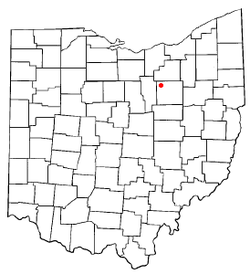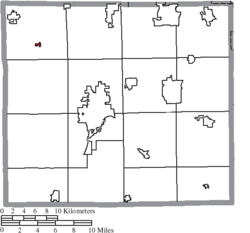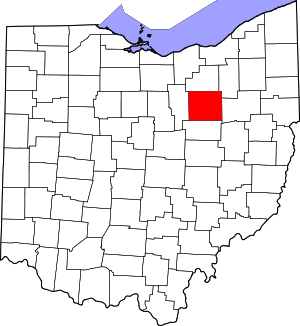Congress, Ohio
Congress is a village in Wayne County, Ohio, United States. The population was 185 at the 2010 census.
Congress, Ohio | |
|---|---|
 Presbyterian Church in Congress | |
 Location of Congress, Ohio | |
 Location of Congress in Wayne County | |
| Coordinates: 40°55′32″N 82°3′12″W | |
| Country | United States |
| State | Ohio |
| County | Wayne |
| Area | |
| • Total | 0.16 sq mi (0.41 km2) |
| • Land | 0.16 sq mi (0.41 km2) |
| • Water | 0.00 sq mi (0.00 km2) |
| Elevation | 1,161 ft (354 m) |
| Population | |
| • Total | 185 |
| • Estimate (2019)[4] | 177 |
| • Density | 1,106.25/sq mi (427.29/km2) |
| Time zone | UTC-5 (Eastern (EST)) |
| • Summer (DST) | UTC-4 (EDT) |
| ZIP code | 44287 |
| Area code(s) | 419 |
| FIPS code | 39-18308[5] |
| GNIS feature ID | 1060994[2] |
Congress was originally called Waynesburg, and under the latter name was laid out in 1827.[6]
Geography
Congress is located at 40°55′32″N 82°3′12″W (40.925447, -82.053222).[7]
According to the United States Census Bureau, the village has a total area of 0.16 square miles (0.41 km2), all of it land.[8]
Demographics
| Historical population | |||
|---|---|---|---|
| Census | Pop. | %± | |
| 1870 | 309 | — | |
| 1880 | 301 | −2.6% | |
| 1890 | 229 | −23.9% | |
| 1900 | 198 | −13.5% | |
| 1910 | 164 | −17.2% | |
| 1920 | 123 | −25.0% | |
| 1930 | 126 | 2.4% | |
| 1940 | 157 | 24.6% | |
| 1950 | 186 | 18.5% | |
| 1960 | 186 | 0.0% | |
| 1970 | 205 | 10.2% | |
| 1980 | 178 | −13.2% | |
| 1990 | 162 | −9.0% | |
| 2000 | 192 | 18.5% | |
| 2010 | 185 | −3.6% | |
| Est. 2019 | 177 | [4] | −4.3% |
| U.S. Decennial Census[9] | |||
2010 census
As of the census[3] of 2010, there were 185 people, 65 households, and 48 families living in the village. The population density was 1,156.3 inhabitants per square mile (446.4/km2). There were 72 housing units at an average density of 450.0 per square mile (173.7/km2). The racial makeup of the village was 97.3% White, 0.5% African American, 0.5% Asian, and 1.6% from two or more races. Hispanic or Latino of any race were 2.7% of the population.
There were 65 households, of which 40.0% had children under the age of 18 living with them, 55.4% were married couples living together, 15.4% had a female householder with no husband present, 3.1% had a male householder with no wife present, and 26.2% were non-families. 16.9% of all households were made up of individuals, and 4.6% had someone living alone who was 65 years of age or older. The average household size was 2.85 and the average family size was 3.15.
The median age in the village was 35.7 years. 29.7% of residents were under the age of 18; 10.3% were between the ages of 18 and 24; 21% were from 25 to 44; 28.5% were from 45 to 64; and 10.3% were 65 years of age or older. The gender makeup of the village was 45.4% male and 54.6% female.
2000 census
As of the census[5] of 2000, there were 192 people, 64 households, and 52 families living in the village. The population density was 1,154.2 people per square mile (436.1/km2). There were 68 housing units at an average density of 408.8 per square mile (154.4/km2). The racial makeup of the village was 97.40% White, and 2.60% from two or more races.
There were 64 households, out of which 29.7% had children under the age of 18 living with them, 73.4% were married couples living together, 3.1% had a female householder with no husband present, and 18.8% were non-families. 14.1% of all households were made up of individuals, and 6.3% had someone living alone who was 65 years of age or older. The average household size was 3.00 and the average family size was 3.35.
In the village, the population was spread out, with 25.5% under the age of 18, 10.9% from 18 to 24, 25.5% from 25 to 44, 29.2% from 45 to 64, and 8.9% who were 65 years of age or older. The median age was 35 years. For every 100 females there were 111.0 males. For every 100 females age 18 and over, there were 110.3 males.
The median income for a household in the village was $36,875, and the median income for a family was $42,083. Males had a median income of $22,321 versus $19,375 for females. The per capita income for the village was $14,911. About 9.1% of families and 4.1% of the population were below the poverty line, including none of those under the age of eighteen or sixty five or over.
References
- "2019 U.S. Gazetteer Files". United States Census Bureau. Retrieved July 27, 2020.
- "US Board on Geographic Names". United States Geological Survey. 2007-10-25. Retrieved 2008-01-31.
- "U.S. Census website". United States Census Bureau. Retrieved 2013-01-06.
- "Population and Housing Unit Estimates". United States Census Bureau. May 24, 2020. Retrieved May 27, 2020.
- "U.S. Census website". United States Census Bureau. Retrieved 2008-01-31.
- Overman, William Daniel (1958). Ohio Town Names. Akron, OH: Atlantic Press. p. 33.
- "US Gazetteer files: 2010, 2000, and 1990". United States Census Bureau. 2011-02-12. Retrieved 2011-04-23.
- "US Gazetteer files 2010". United States Census Bureau. Archived from the original on 2012-01-25. Retrieved 2013-01-06.
- "Census of Population and Housing". Census.gov. Retrieved June 4, 2015.
